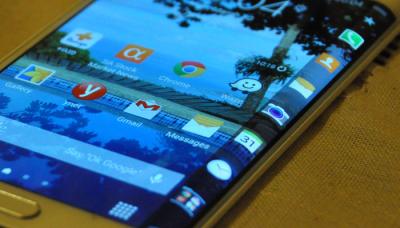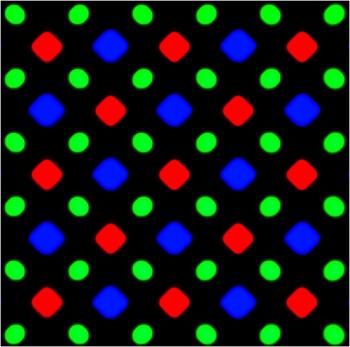Super AMOLED: introduction and market status
OLED displays use organic materials that emit light when electricity is applied. OLEDs enable emissive, bright, thin, flexible and efficient displays. OLEDs are replacing LCDs in most display applications - from smartphones and wearables to monitors and TVs.

Samsung's Super AMOLED displays, announced in 2010, are AMOLED displays for mobile devices (such as smartphones, wearables and tablets) with an integrated touch function. The thickness of the touch sensor is just 0.001 mm and this allows the screen to provide better images and to have great visibility even in direct sunlight compared with regular AMOLED displays with an external touch layer.
Samsung is producing hundreds of millions of Super AMOLED displays today, used mostly in smartphones, but also in other devices. These are considered to be some of the best displays on the market.
Super AMOLED and the Pentile matrix
Samsung's Super AMOLED displays use a Pentile matrix sub-pixel design. That means that the green sub-pixel is shared by two pixels and the display has only 2 sub-pixels per real 'pixel' compared to the classic RGB matrix design (or Real-Stripe). You can see a PenTile matrix vs a Real-Stripe one on the images below (the PenTile is on the right). Newer Super AMOLED displays use a different PenTile matrix (Diamond Pixel pattern).
Super AMOLED vs Dynamic AMOLED
In 2019 Samsung introduced its next-generation mobile display technology, which it calls Dynamic AMOLED. Basically a Dynamic AMOLED is similar to a Super AMOLED display, but it adds HDR support. Samsung's highest end smartphones adopt the company's Dynamic AMOLED 2X LTPO AMOLED displays.
Further reading
- Introduction to OLEDs
- Samsung's OLED displays
- Pentile Technology explained
- Flexible OLEDs
- OLED mobile phones
- The OLED Toolbox: a one-stop-shop for OLED information, insights, analysis and guides
Samsung says the GS4 will hit the 10 million sales market soon
Samsung has high hopes for the Galaxy S4 (they actually hope to sell over 100 million units - or double the GS3 sales). Today the company reported that they will soon reach 10 million units sold - less than a month after launching the phone (update: on May 23 Samsung announced that indeed they reached the 10 million sales mark).

The GS3 took 50 days to reach 10 million in sales, so the GS4 is selling at a much faster rate (almost double the rate actually). Google just announced that they will offer a GS4 model with stock Android 4.2 on their Google Play on June 26 for $649, this won't hurt sales rate I guess.
Diamond Pixel: the unique GS4 sub pixel arrangement
When Samsung launched the GS4, they said the Super AMOLED display uses PenTile. Back in January, it was reported that Samsung will adopt a new subpixel scheme that uses diamond sub-pixels, but up until now we didn't hear anything official from Samsung. Today the company finally did acknowledge the new design, and published two closeup photos of the GS4 display.

Diamond Pixel, as Samsung's calls their new design, is a PenTile subpixel scheme, in which there are twice as many green subpixels as there are blue and red ones. The green subpixels are oval and small while the red and blue ones are diamond-shaped and larger (the blue subpixel is slightly larger than the red one). DisplayMate says that this is because green is the most efficient (and long lasting) OLED emitter while the blue has the shortest lifetime.
Samsung aims to sell 100 million GS4, orders so far has been "explosive"
Samsung says that orders for the Galaxy S4 so far has been "explosive". In fact the company didn't anticipate such strong orders and cannot meet demand (they have a shortage of memory chips, apparently). Samsung have high hopes for the S4, and they hope to sell over 100 million units - that's double compared to the S3 (which sold 50 million units so far).

In fact all the phones in the Galaxy S series together just recently crossed the 100 million units mark. In January 2013 Samsung announced that the GS2 sold 40 million units, the GS3 sold 30 million and GS1 sold almost 30 million.
DisplayMate: the GS4 display is very impressive, OLEDs finally challenge the best LCD displays
DisplayMate, the experts on display optimization, testing and evaluation, posted a new article comparing the GS4 display (4.99" Full-HD, 441 PPI) to the iPhone 5's LCD and the GS3. The GS4's Super AMOLED is a "very impressive display", and DisplayMate says that OLEDs have now reached the stage when they challenge the best LCD displays. There are advantages and disadvantages to both technologies, but we have to keep in mind that OLEDs are advancing at a much more rapid rate compared to LCDs which is now a mature technology.
 Samsung Galaxy S4
Samsung Galaxy S4
Compared to the S3, the S4 is brighter by 25% (and when using Automatic Brightness, it's 68% brighter as this setting allows the brightness to reach a high level unreachable in manual brightness mode), it's 20% more power efficient (due to the green PHOLED materials) and it's got 44% more pixels per inch (and more than double the total number of pixels).
US carriers to start shipping Samsung's GS4 this week
US carriers will start shipping the GS4 this week. AT&T will probably be the first one as they aim to start shipping on Tuesday (April 23). Most other carriers (including Sprint, T-Mobile and US Cellular) will ship a week layer (April 30). it will be very interesting to see the market's reaction to Samsung's new flagship phone.

The GS4 features a 4.99" Full-HD (1920x1280, 441 PPI) Super AMOLED display, an Octacore 1.6Ghz Exynos CPU (some models use a Quadcore 1.9Ghaz Qualcomm CPU), 2GB of memory, 13 mp camera and a 2,600mAh battery - all this while being a smaller and lighter than the GS3. The GS4 includes a lot of new software features and special UI controls, include the Adapt Display which allows extensive display calibration adjustments.
Blackberry is getting ready to ship the AMOLED Q10 soon
In January 2013 Blackberry announced their first AMOLED phone, the Q10, with a square 3.2" 720x720 (330 ppi)Super AMOLED display. It seems that the company is ready to launch this new phone soon. Canadian carrier Rogers will reportedly start to sell it on April 30 for $200 on a 3-year contract. UK's Phones4U has begun to take pre-orders (£36 a month on contract or £549.95 unlocked) with shipments expected by the end of April. The Q10 has also passed through the FCC and approved it for a US launch.

Other Q10 features include a hardware keyboard, LTE, 1.5Ghz dual-core CPU and 2GB of RAM. This is Blackberry's first hardware keyboard device to sport the company's new BB10 OS.
SamMobile: Samsung is developing a high end 10.1" or 11.6" Super AMOLED tablet
After SamMobile mishap with the GS4-LCD-rumor, I didn't think I'll post on yet another of their rumors, but as always happens, many web sites picked up their latest one so I'm going to post as well. This time the blog reports that Samsung is working on a high-end tablet device (that will be called the Galaxy Tab 3 Plus). This tablet will feature a large (10.1" or 11.6", apparently Samsung did not decide yet) Full-HD Super AMOLED display.

SamMobile says that they want to go with a Super AMOLED because many Galaxy Tab 7.7 users still believe it's the best tablet on the market because of the display. They say the company hopes to unveil the new tablet at the IFA 2013 exhibition (September 23), together with the Note 3.
UK retailer says Galaxy S4 pre-orders are up 446% compared to the S3
According to UK Carphone Warehouse, the GS4 is going to be very popular - in the first 3 days of offering pre-orders, there were 446% more pre-registrations than with the GS3 - the most popular Android phone ever. CW's COO says that the S4 "is the one to watch for 2013".

The GS4 features a 4.99" Full-HD (1920x1280, 441 PPI) Super AMOLED display, an Octacore 1.6Ghz Exynos CPU (some models use a Quadcore 1.9Ghz Qualcomm CPU), 2GB of memory, 13 mp camera and a 2,600mAh battery - all this while being a smaller and lighter than the GS3. The GS4 includes a lot of new software features and special UI controls, include the Adapt Display which allows extensive display calibration adjustments.
iSupply - the S4 cost is estimated at $236, the 5" AMOLED costs $75
IHS iSuppi posted a "virtual teardown" for the upcoming Galaxy S4, saying that the bill of materials is about $236 (for the HSPA+ S4 with 16 gigabytes of NAND flash). According to iSuppli, the 5" Full-HD Super AMOLED display costs $75. As the 4.8" WXGA AMOLED on the S3 costs $65, this represents the largest cost increase for the S4 compared to its predecessor (The cost of making an S3 is estimated at $208). The cost of the AMOLED display is over 30% of the cost of the entire S4.

Other expensive components on the HSPA+ S4: the Exynos 5 processor at $30, memory (NAND + Flash) at $28, the two cameras at $20, the UI and sensor subsystem at $16 and the HSPA+ chip at $16. You can see the complete list on the table above, which includes also the S4 LTE and S3 Built-Of-Materials (BOM) estimates.
The S4 to offer extensive display calibration adjustments
Raymond Soneira, Displaymate's display guru (and our friend) has previously criticized Samsung for the lack of calibration on their AMOLED displays - the colors are too saturated, the whites are too blue, and the intensity scales are too steep. This is hopefully going to change with the S4 however. Samsung is including a new feature in the S4 called Adapt Display that offers seven automatic modes and four manual modes - to provide the optimal viewing experience.

As Raymond points out, Samsung's own S4 site shows a CIE chromaticity diagram and a gray scale level picker (see screenshot above). This leads Raymond to believe that the S4 will have extensive color, white-point, and display calibration adjustments. This could be a "major display advancement and a win for Samsung and AMOLED displays" - according to Raymond.
Pagination
- Previous page
- Page 11
- Next page

